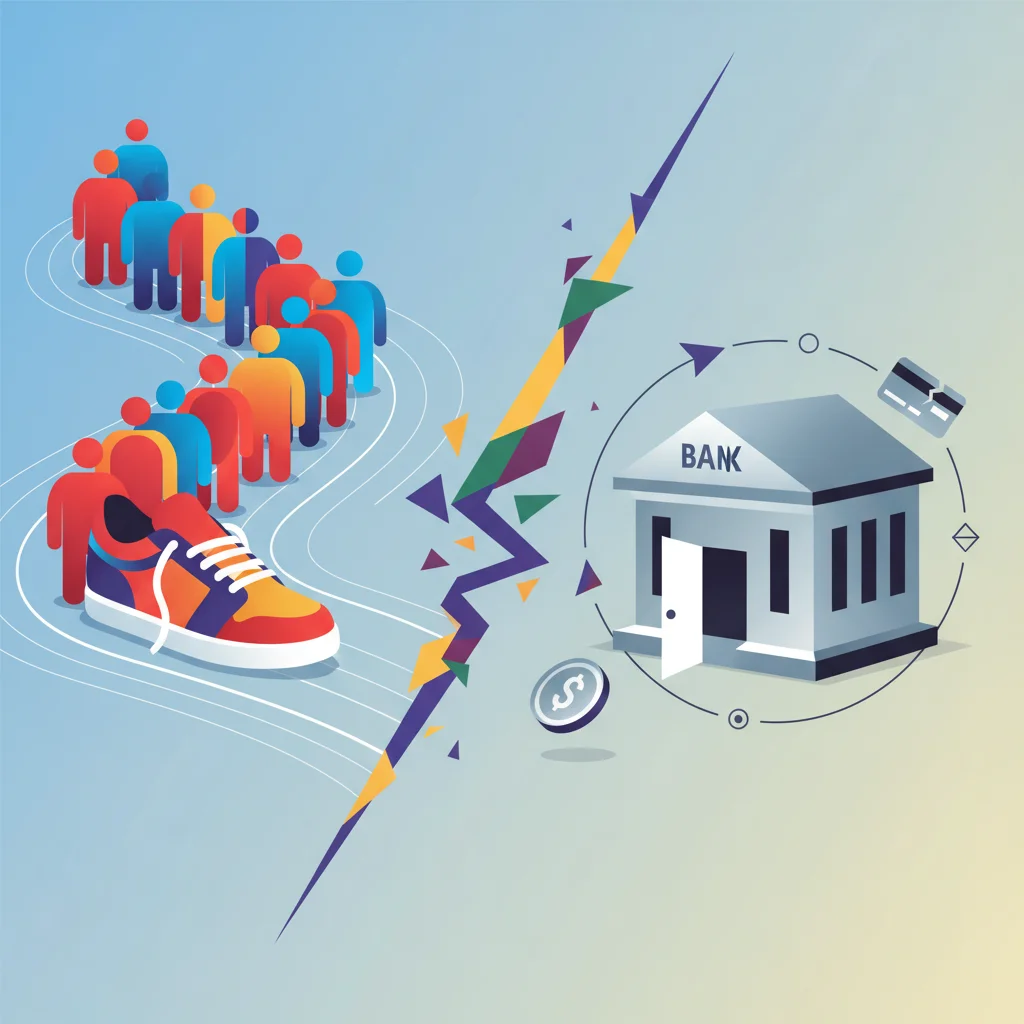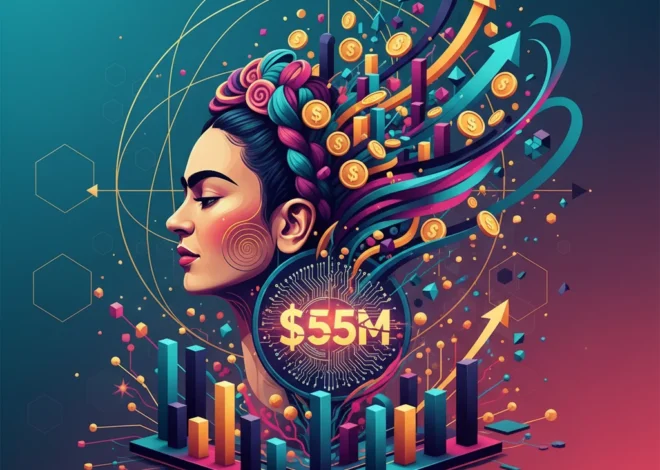
The Sneaker Queue vs. The Empty Bank: A Stark Lesson in Modern Finance
It’s a scene many of us have witnessed in a bustling city center. On one side of the street, a line of eager, expectant people snakes around the block, buzzing with anticipation. They’re not waiting for a concert or a movie premiere. They’re waiting for the “drop” of a new, limited-edition pair of sneakers. Across the street stands a stark contrast: a well-appointed bank branch, its doors open, its interior quiet, perhaps with more staff than customers.
This exact juxtaposition was recently highlighted in a poignant letter to the Financial Times by New Yorker Richard M Warshauer. From his office window, he observed the “long line of people waiting to get into the Nike store” while noting the “empty bank branches” nearby. He concluded with a simple, yet profound question: “Which industry has the better business model?”
This isn’t just a fleeting observation; it’s a powerful parable for the seismic shifts occurring in our modern economy. It’s a story about value, community, customer experience, and the fundamental transformation of the banking and finance industries. The empty bank branch isn’t a sign of failure, but a symbol of a revolution that has already happened. The real question is whether the financial sector is learning the right lessons from the industries that are capturing the hearts, minds, and wallets of the modern consumer.
The Anatomy of the Queue: Deconstructing the Hype Economy
To understand the empty bank, we must first understand the full sneaker store. The queue outside a Nike or Supreme store is not merely about footwear; it’s a masterclass in modern marketing, community building, and value creation. This is the “Hype Economy” in action, and it’s built on several key pillars:
- Engineered Scarcity: Limited releases create intense demand and a fear of missing out (FOMO). Unlike a bank account, which is universally available, these products are exclusive. This scarcity transforms a consumer good into a status symbol and a collectible asset.
- Community and Culture: Sneaker culture has its own language, hierarchies, and social platforms. Owning a specific pair of shoes is a passport into a global community. The brand isn’t just selling a product; it’s facilitating an identity.
- The Secondary Market: The “hype” is amplified by a booming resale market. A $200 sneaker can be worth thousands on platforms like StockX, turning consumers into investors and traders. This ecosystem, valued at an estimated $30 billion globally by 2030, adds a tangible investing dimension to the purchase. The queue isn’t just for a product; it’s for an asset with potential for significant ROI.
This model generates a level of brand loyalty and emotional connection that most financial institutions can only dream of. People don’t just use the product; they evangelize it. This passion is a currency that is becoming more valuable than ever.
Neom: A Visionary Investment or a Multi-Trillion Dollar Mirage?
The Echo in the Bank: The Quiet Revolution of Fintech
Across the street, the silence in the bank branch tells a different story. It’s not one of disinterest in finance, but a radical change in how we engage with it. For decades, the physical branch was the bedrock of banking—a symbol of stability, trust, and personal connection. Today, for a growing majority, it’s an inconvenience.
The revolution is being driven by financial technology, or fintech. The bank isn’t empty because people stopped banking; it’s empty because the bank is now in their pocket. Consider the data: in the United States, more than 2,900 commercial bank branches were permanently closed in 2021, the highest number on record, according to an analysis by S&P Global Market Intelligence. Meanwhile, the number of digital banking users in the U.S. is projected to exceed 217 million by 2025.
This digital migration has fundamentally altered the landscape. Fintech startups and neobanks have unbundled traditional banking services, offering slick, user-friendly apps for everything from payments and trading on the stock market to loans and savings. They have replaced the personal touch of a bank teller with the hyper-personalized touch of an algorithm.
To visualize this dramatic shift, let’s compare the two models:
| Feature | Traditional Banking Model | Modern Fintech Model |
|---|---|---|
| Primary Interface | Physical Branch / In-Person | Mobile App / Website |
| Customer Acquisition | Location, Reputation, Legacy | Digital Marketing, Low Fees, UX |
| Value Proposition | Security, Stability, Full-Service | Convenience, Speed, Personalization |
| Overhead Costs | High (Real Estate, Staffing) | Low (Technology, Lean Teams) |
| Customer Engagement | Transactional, Infrequent | Continuous, Data-Driven, In-App |
The table makes it clear: the business model of banking hasn’t just evolved; it has been completely inverted. The focus has shifted from physical presence to digital excellence, from universal service to niche specialization.
The New Currency of the Digital Age: Attention and Trust
The core of the issue boils down to a battle for two of the most valuable resources in the modern economy: attention and trust. The sneaker brand commands attention through cultural relevance and masterful storytelling. It builds trust not through institutional legacy, but through consistent delivery on its brand promise of quality, exclusivity, and identity.
Traditional banks, on the other hand, have long operated on a foundation of institutional trust. But this foundation is being chipped away. For younger generations, trust is built through transparent processes, seamless digital experiences, and peer validation—areas where fintechs often excel. The commoditization of financial products means that for many, one bank is as good as another, and the decision often comes down to who offers the best app or the lowest fees.
This is where disruptive technologies like blockchain enter the conversation. Decentralized Finance (DeFi) represents the ultimate unbundling, threatening to create a financial system that requires no central intermediary at all. While still nascent, it underscores the trend: trust is shifting from institutions to technology and networks. For a bank to compete, it can no longer rely on its history; it must actively and continuously earn the trust and attention of its customers every single day.
Indonesia at a Crossroads: Prabowo, the Suharto Legacy, and the High-Stakes Game for Investors
The Path Forward: Reimagining the Financial Customer Experience
So, which business model is better? The answer is that the best model will be a hybrid, taking the most powerful elements from both worlds. The future of finance isn’t just digital; it’s experiential. Here are the key takeaways for investors and business leaders:
- Transform the Physical Space: The bank branch isn’t dead, but its purpose as a transactional hub is. The branches that survive will be reimagined as advisory centers, community event spaces, or educational hubs. Think less teller windows, more Apple Store Genius Bar for your financial life.
- Embrace “Product Drops”: Banks can learn from scarcity and exclusivity. Imagine offering a limited number of clients early access to a high-performing fund, a fixed-rate savings bond with an above-market yield, or a beta version of a new wealth management tool. This creates buzz and rewards loyalty.
- Build a Community, Not Just a Customer Base: Financial institutions must invest in content, education, and tools that help people improve their financial literacy. By creating a community around the shared goal of financial well-being, a bank can foster a level of loyalty that transcends interest rates. According to a Forbes Advisor survey, a top-notch mobile experience is a key reason customers switch banks, highlighting the importance of the digital community space.
- Invest in Hyper-Personalization: The true power of financial technology is its ability to use data to provide uniquely tailored advice and products. The bank of the future will know your financial goals and proactively offer solutions, making you feel like a valued client, not an account number.
Bismarck's Ghost: Why 19th-Century Russian Strategy Haunts Today's Global Economy
Conclusion: The View from the C-Suite
The view from across the street is a wake-up call. It shows a world where passion, community, and experience can create immense value and command fierce loyalty. The banking industry, for all its digital transformation, has largely focused on utility and convenience, often neglecting the emotional connection that builds a truly resilient brand.
The challenge for every financial leader and investor is to look past the spreadsheets and stock market charts and see the human element. The question is no longer just “How do we make banking easier?” but “How do we make it more meaningful?” The institution that can answer that question will not only survive the fintech revolution but will lead the next era of finance. They will be the ones who finally figure out how to create a queue—not of people waiting in the cold for a product, but of dedicated customers eager to invest in their own future.

